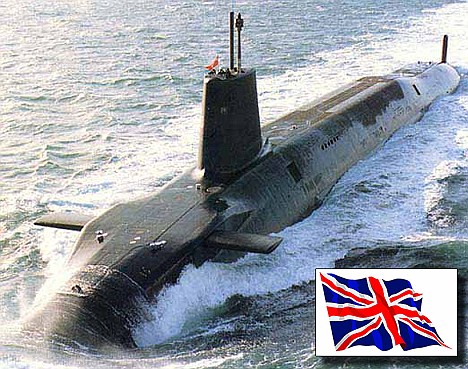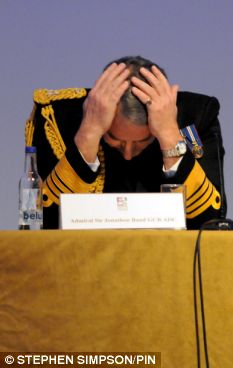How close did crash submarines packed with nuclear missiles come to disaster?
By Peter Allen and Tom Kelly
Last updated at 7:47 AM on 17th February 2009A huge disaster was narrowly avoided when British and French nuclear submarines crashed in the Atlantic, a marine engineer said yesterday.
The vessels, which are armed with up to 32 ballistic missiles between them, collided 1,000ft underwater in the Bay of Biscay.
French sailors, who were returning to base, heard a bang after HMS Vanguard apparently clipped the front of their submarine, Le Triomphant.

HMS Vanguard, the lead boat of her class in the Royal Navy, had to be towed back to her base in Scotland after the underwater mishap
The French vessel's fibreglass sonar dome was shattered in the collision, causing £50million of damage.
The Vanguard was forced to return to Faslane, in Scotland, where it arrived at the weekend with 'very visible dents and scrapes', witnesses said.

French sources confirmed Le Triomphant, pictured, was involved in a collision with Vanguard
Yesterday First Sea Lord Admiral Sir Jonathon Band confirmed the collision, which happened on February 3.

Admiral Sir Jonathon Band confirmed the collision at a Royal Navy press conference
There was no nuclear leak and no injuries to the crew, he said. The Ministry of Defence declined to comment further, citing operational secrecy.
However, experts and MPs called for a full explanation.
Dr John Large, a nuclear submarine engineer who has advised the Royal Navy,
said: 'This could easily have been very serious. There could have been a massive humanitarian disaster.
'If any plutonium from the m
issiles or reactors had got into the atmosphere there would have been a likelihood of causing both immediate deaths among people who breathed in the particles - and a big increase in cancers over the next three decades.'
The £4billion vessels were believed to be in 'stealth mode', moving at just four-and-a-half miles an hour, with most of their systems switched off, when they collided.
They avoid using active or 'pinging' sonar to find other objects, as it would give away their own position.
The sophisticated passive sonar systems - listening for sounds from another vessel - would be switched on.
But as both subs move astonishingly quietly, they were able to blunder into each other without either spotting the other.

Navy insiders say the French submarine may have been the only vessel at sea at the time with which Vanguard could have collided in this way.

Where the subs met
Chinese and Russian submarines are thought to be noisier and easier to detect.
U.S. vessels are just as quiet as Britain's but the countries exchange information on where their submarines are patrolling.
There is no information-sharing deal with France, it is understood.
Dr Large, who led the operation to raise the Russian Kursk submarine which sank in 2000, added: 'It's like two blindfolded men creeping around a room. Eventually they are going to bump into each other.
'Nuclear power stations are subjected to strict regulations and have to be accountable when accidents happen. The same standards should apply to the MoD.'
A worse accident could easily happen, he warned.
'The Atlantic is very big, but most navies use the same nesting grounds, quiet areas, deep areas, roughly the same distance from their home ports.
'These station-grounds have got quite a few submarines, meaning there is always the risk of a crash.'
Angus Robertson, Westminster leader of the Scottish National Party, said: 'The MoD needs to explain how it is possible for a submarine, carrying weapons of mass
destruction, to collide with another submarine carrying weapons of mass destruction, in the middle of the world's second-largest ocean.
'The MoD cannot hide behind operational secrecy - and must make a statement on this as a priority.'

This 1994 photo taken by a US Navy employee shows HMS Vanguard arriving in port in Florida
The French initially said Le Triomphant had probably hit a sunken container from a ship. It took three days to limp back to base.
Neither France nor Britain would confirm the exact date of the collision, but said it took place earlier this month.
France issued a brief statement February 6 saying the Le Triomphant had struck 'a submerged object' that was probably a shipping container.
Naval experts were amazed by the collision.
'This really shouldn't have happened at all,' said Stephen Saunders, a retired British Royal Navy commodore and the editor of Jane's Fighting Ships.
'It's a very serious incident, and I find it quite extraordinary.'

He said while Nato countries let each other know what general area of the Atlantic they are operating in, neither submarine would have had a precise position for the other.
Saunders said submarines don't always turn on their radar systems or make their presence obvious to other shipping.
'The whole point is to go and hide in a big chunk of ocean and not be found. They tend to go around very slowly and not make much noise,' he said.
Lawmakers and disarmament advocates demanded an explanation of how the submarines could have failed to detect each other.
Britain's government 'needs to explain how it is possible for a submarine carrying weapons of mass destruction to collide with another submarine carrying weapons of mass destruction in the middle of the world's second-largest ocean,' lawmaker Angus Robertson of the opposition Scottish National Party said.
Source: http://www.dailymail.co.uk/news/worldnews/article-1146124/How-close-did-crash-submarines-packed-nuclear-missiles-come-disaster.html
